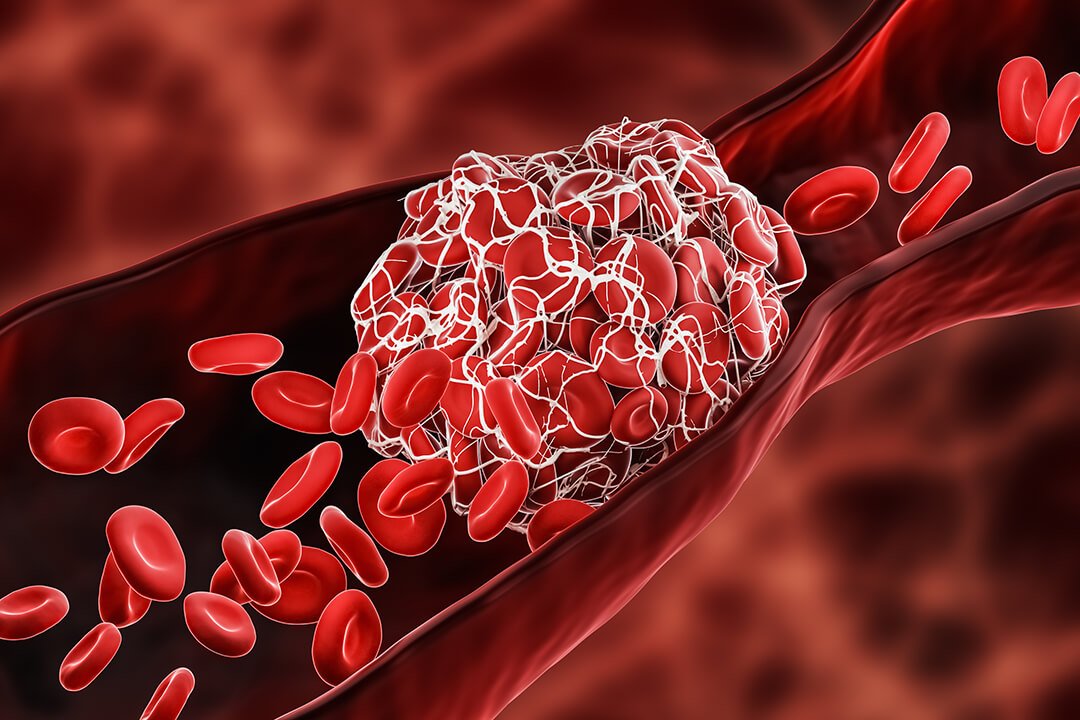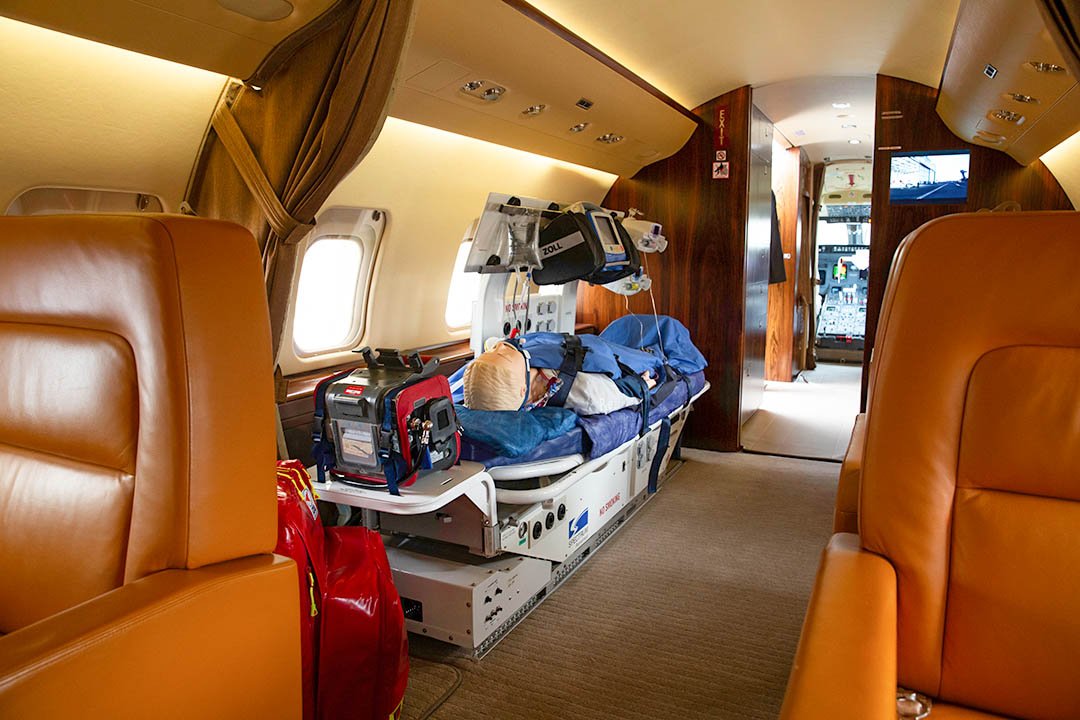Reading Time: 4 minutes
Table of contents
- Can you fly with a stent in your heart?
- What is a stent and why you might need one?
- Risks after a heart stent surgery: What are the possible complications?
- How soon can you fly after having a stent fitted?
- Flying after a heart stent surgery: dangers in a commercial flight for angioplasty patients
- Your alternative to flying commercially with a stent: air ambulances
- A medical escort for patients with a heart stent - flying after angioplasty surgery
- Why should patients with a heart stent book an air ambulance with us?
- Contact us if you need to travel with a heart stent
Can you fly with a stent in your heart?
Many of our customers are curious as to whether it is safe to fly after a stent procedure. With more than 190 million people across the globe being affected by coronary heart disease (CHD) and cardiovascular diseases being the leading cause of death worldwide, the regularity of heart stent surgeries should not be surprising. In the US alone, approximately one million people, if not more, have this stenting procedure per year. What are the important things that you should be aware of if you intend to take a flight with a heart stent?
What you should know if you wish to fly with a heart stent or following coronary angioplasty
- Patients who have had a heart stent surgery are at an increased risk of blood clots
- Always seek the advice of your doctor to determine whether you are fit to fly
- If you do not have any complications after the heart surgery, you can fly on a commercial flight with a medical escort, after waiting for the required period of time.
- If you need to fly just after heart stent surgery or in case of complications, an air ambulance is the better option
- Medical Air Service can conduct sea-level flights which decrease the potential risks of flying after surgery

What is a stent and why you might need one?
A stent is a tiny tube that is placed inside a blocked artery to improve blood flow. They are either made out of:
- wire mesh that is permanent, or
- of another material, that dissolves and is absorbed by your body. This is coated with medication that prevents your arteries from being blocked again.
When plaque (a fatty substance) builds up inside an artery, it can either reduce blood flow to your heart, causing chest pain (coronary artery disease) or block the artery, preventing blood from flowing to your heart, which might lead to a heart attack.
Implanting a heart stent will help improve blood flow, which will reduce symptoms such as chest pain or shortness of breath. A heart stent surgery (angioplasty) is for patients with obstructive artery disease. It is sometimes conducted instead of bypass surgery if possible.
Important to note: a heart stent will not cure coronary heart disease and won’t reduce your risk factors. Lifestyle changes are primordial for this.
Risks after a heart stent surgery: What are the possible complications?
In general cases, recovery from a heart stent procedure is fast. However, there are some complications or some risks that you should be aware of.
- Bruising, which is harmless and disappears after a few days
- Bleeding where the tube was inserted
- Blood clots: the risk of a blood clot is highest a few months after the procedure, which can put you at risk of a heart attack or a stroke. Doctors prescribe antiplatelet (anti-clotting) drugs for at least one year after the angioplasty.
- Infection; usually noticed within the first four weeks.
- Irregular heartbeat.

How soon can you fly after having a stent fitted?
In usual cases, following an angioplasty, a patient is allowed to gradually resume activities that are not too tiring and strenuous after a week. Flying is generally possible after the same amount of time. However, this is on the condition that there are no complications and is dependent on your doctor’s approval. Before making any travel plans, always check with your doctor whether you are fit to fly.
Flying after a heart stent surgery: dangers in a commercial flight for angioplasty patients
One of the risks of flying commercially after an angioplasty is the change in cabin pressure which can lead to reduced levels of oxygen in the body. This might not be noticeable to normal passengers but can be extremely detrimental to those with a still fragile immune system. Considering the slower blood flow due to the lower air pressure in the aircraft cabin, combined with the prolonged state of immobility during long-haul flights and the already increased risk after heart stent surgery, travelers should be on the lookout for blood clots, also known as deep vein thrombosis (DVT).
A DVT can be harmful in the sense that it can travel to your lungs and heart, obstructing blood flow, and leading to a stroke or even a heart attack. In case of such an emergency mid-flight, a commercial airliner is neither staffed nor equipped appropriately to provide the patient with the necessary care and treatment.
Your alternative to flying commercially with a stent: air ambulances
The safest way to fly following an angioplasty is by an air ambulance. These are medical flights that are fitted with the latest medical equipment and come with doctors and paramedics on board.
 At Medical Air Service, we make sure to customize our air ambulances with the necessary equipment and specialist doctors based on the patient’s medical condition. In the case of a heart stent surgery, we are going to assess the patient, determine his needs and implement the necessary safety procedures. The medical equipment in our air ambulances is similar to those available in an ICU, ensuring maximum safety for the patient
At Medical Air Service, we make sure to customize our air ambulances with the necessary equipment and specialist doctors based on the patient’s medical condition. In the case of a heart stent surgery, we are going to assess the patient, determine his needs and implement the necessary safety procedures. The medical equipment in our air ambulances is similar to those available in an ICU, ensuring maximum safety for the patient
For instance, we can organize a sea-level flight for patients who cannot withstand the change in cabin pressure. This means that we will adjust the air pressure inside the cabin to be closer to the pressure at sea level, ensuring a stable level of oxygen in the patient's body.
Additionally, in cases of medical emergencies mid-air, our flight doctors are ready and equipped to intervene at all times. We can have doctors specializing in cardiology on board to provide patients with the most efficient treatment possible.
A medical escort for patients with a heart stent - flying after angioplasty surgery
We also offer a medical escort service on commercial flights. This option is ideal for patients who have had heart stent surgery a while back and are in a stable condition but still need some form of medical supervision while traveling.
The medical escort will provide assistance, reassurance and care to the patient throughout the fIight. An expert in the aeromedical field, he is going to monitor the patient’s condition and to provide emergency care if required. He will also help him during the check-in and boarding processes, which will lighten some of the physical hardships for the patient, making the flight a less tiring one.
Why should patients with a heart stent book an air ambulance with us?
At Medical Air Service, our goal is to ensure that patients are as safe and as comfortable as possible during a patient transport. We ensure to ease their burden, whether it is physical or mental as soon as they get in touch with us. We do that by:
- Providing them with a free consultation session with our aviation experts to determine their needs
- Taking care of the whole transportation process
- Dealing with formalities and paperwork related to flight permits etc
- Assisting them with hospital admission and communicating with doctors
- Organizing ground transportation (ground ambulances) in both countries
- Providing them with a flight the next day of the booking, if possible
- Allowing a loved one to accompany them on the flight for free, if possible
- Customizing the air ambulance cost to alleviate some of their financial burdens
Contact us if you need to travel with a heart stent
If you have had heart stent surgery or are at high risk of a heart attack, get in touch with us. During a free consultation session with our experts, we will determine whether you need a medical escort or an ambulance and we will work out the safest and most efficient way possible for the flight.
Get in touch now